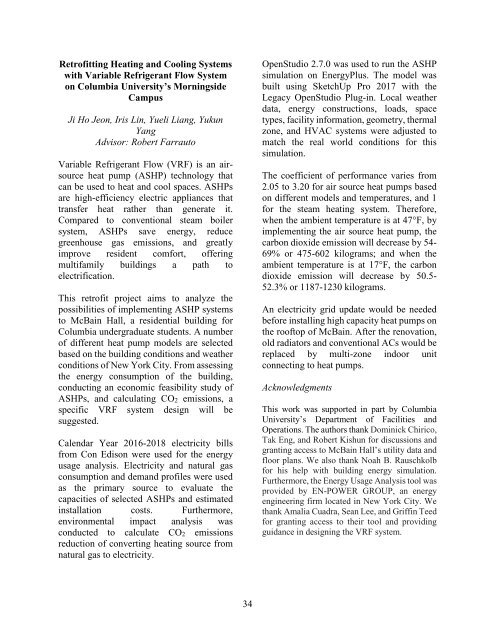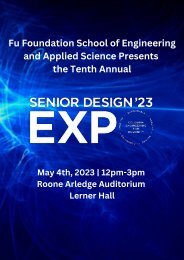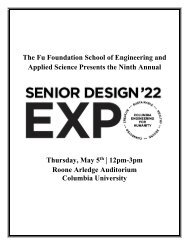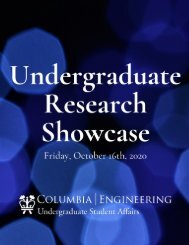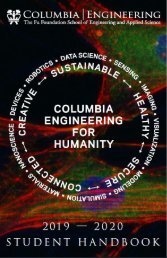Senior Design Expo 2019
The Senior Design Expo, held annually in May at Columbia University, is an opportunity for Columbia Engineering students to showcase what they have learned in their foundational math and science courses together with their engineering courses in innovative, creative, and purposeful designs and prototypes. Each year the Expo showcases more than 60 projects across all nine departments. Projects have included cutting-edge robotics, the New York City subway system, language technology, proposals for bridges to span the Hudson river, and much more.
The Senior Design Expo, held annually in May at Columbia University, is an opportunity for Columbia Engineering students to showcase what they have learned in their foundational math and science courses together with their engineering courses in innovative, creative, and purposeful designs and prototypes. Each year the Expo showcases more than 60 projects across all nine departments. Projects have included cutting-edge robotics, the New York City subway system, language technology, proposals for bridges to span the Hudson river, and much more.
You also want an ePaper? Increase the reach of your titles
YUMPU automatically turns print PDFs into web optimized ePapers that Google loves.
Retrofitting Heating and Cooling Systems<br />
with Variable Refrigerant Flow System<br />
on Columbia University’s Morningside<br />
Campus<br />
Ji Ho Jeon, Iris Lin, Yueli Liang, Yukun<br />
Yang<br />
Advisor: Robert Farrauto<br />
Variable Refrigerant Flow (VRF) is an airsource<br />
heat pump (ASHP) technology that<br />
can be used to heat and cool spaces. ASHPs<br />
are high-efficiency electric appliances that<br />
transfer heat rather than generate it.<br />
Compared to conventional steam boiler<br />
system, ASHPs save energy, reduce<br />
greenhouse gas emissions, and greatly<br />
improve resident comfort, offering<br />
multifamily buildings a path to<br />
electrification.<br />
This retrofit project aims to analyze the<br />
possibilities of implementing ASHP systems<br />
to McBain Hall, a residential building for<br />
Columbia undergraduate students. A number<br />
of different heat pump models are selected<br />
based on the building conditions and weather<br />
conditions of New York City. From assessing<br />
the energy consumption of the building,<br />
conducting an economic feasibility study of<br />
ASHPs, and calculating CO2 emissions, a<br />
specific VRF system design will be<br />
suggested.<br />
Calendar Year 2016-2018 electricity bills<br />
from Con Edison were used for the energy<br />
usage analysis. Electricity and natural gas<br />
consumption and demand profiles were used<br />
as the primary source to evaluate the<br />
capacities of selected ASHPs and estimated<br />
installation costs. Furthermore,<br />
environmental impact analysis was<br />
conducted to calculate CO2 emissions<br />
reduction of converting heating source from<br />
natural gas to electricity.<br />
OpenStudio 2.7.0 was used to run the ASHP<br />
simulation on EnergyPlus. The model was<br />
built using SketchUp Pro 2017 with the<br />
Legacy OpenStudio Plug-in. Local weather<br />
data, energy constructions, loads, space<br />
types, facility information, geometry, thermal<br />
zone, and HVAC systems were adjusted to<br />
match the real world conditions for this<br />
simulation.<br />
The coefficient of performance varies from<br />
2.05 to 3.20 for air source heat pumps based<br />
on different models and temperatures, and 1<br />
for the steam heating system. Therefore,<br />
when the ambient temperature is at 47°F, by<br />
implementing the air source heat pump, the<br />
carbon dioxide emission will decrease by 54-<br />
69% or 475-602 kilograms; and when the<br />
ambient temperature is at 17°F, the carbon<br />
dioxide emission will decrease by 50.5-<br />
52.3% or 1187-1230 kilograms.<br />
An electricity grid update would be needed<br />
before installing high capacity heat pumps on<br />
the rooftop of McBain. After the renovation,<br />
old radiators and conventional ACs would be<br />
replaced by multi-zone indoor unit<br />
connecting to heat pumps.<br />
Acknowledgments<br />
This work was supported in part by Columbia<br />
University’s Department of Facilities and<br />
Operations. The authors thank Dominick Chirico,<br />
Tak Eng, and Robert Kishun for discussions and<br />
granting access to McBain Hall’s utility data and<br />
floor plans. We also thank Noah B. Rauschkolb<br />
for his help with building energy simulation.<br />
Furthermore, the Energy Usage Analysis tool was<br />
provided by EN-POWER GROUP, an energy<br />
engineering firm located in New York City. We<br />
thank Amalia Cuadra, Sean Lee, and Griffin Teed<br />
for granting access to their tool and providing<br />
guidance in designing the VRF system.<br />
34


